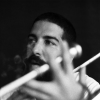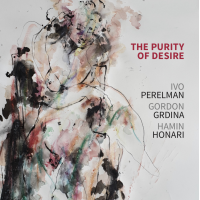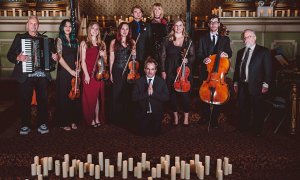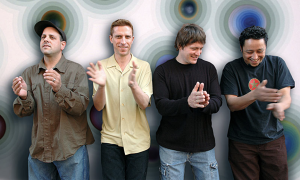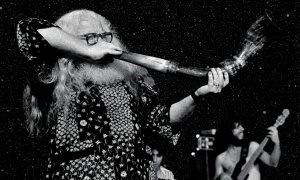Home » Jazz Articles » From the Inside Out » Tributes, Tapestries, Trombones and Tempests
Tributes, Tapestries, Trombones and Tempests

Courtesy Far Out Recordings
 Vasko Atanasovski Adrabesa Quartet
Vasko Atanasovski Adrabesa QuartetPhoenix
MoonJune Records
2020
Phoenix captures the voice of one of Eastern Europe's most acclaimed and creative musical ensembles, the Adrabesa Quartet founded and led by Slovenian maestro Vasko Atanasovski, and amplifies this unique voice throughout MoonJune Records' global distribution network. Phoenix thus demonstrates that the globalization of jazz hasn't muted the strong, perhaps even essential, regional accents in its overall voice.
Founded in 2005, the Adrabesa Quartet on Phoenix features a somewhat unusual though colorful instrumental lineup. Founder and leader Atanasovski is featured on flute and alto and soprano saxophones, and wrote every tune except for the collectively improvised finale "Outro." Italian accordion master Simone Zanchini has served in the Quartet from the start and is also a featured soloist with the Milan Scala Orchestra. Tuba player Michel Godard comes from France, and percussionist Bodek Janke from Poland. Ariel Vei Atanasovski, the leader's teenage son, joins on cello.
On Phoenix, the ensemble's individual musicianship and improvisational skills, and the way everyone plays together, sure sound like jazz. But Atanasovski's compositions string together unique instrumental combinations and textures that can also sound quite different from jazz. The opening "Meeting" first convenes the ensemble, then rips into a dramatic, Eastern European-sounding twirling dance. In "Green Nymph," tuba supports the flute like a bassist might follow a guitarist or pianist singing its melody. Violin swirls in a colorful gypsy sound that introduces this tune's best part, an intuitive and dynamic drum, tuba, and accordion three-way conversation played like a jazz piano trio.
The tuba and accordion players are magic throughout this set. Zanchini opens "Liberation" with intersecting ripples and layers of colorful arpeggios, then drops into the sound of a massive church choir organ, stutters in and out of a sprint and ultimately whirls into a cyclonic solo that sets the spirit of this tune free. Godard's tuba at first blows "Balet" right out of its moorings but rights it to prop up the leader's soprano solo, and then rips into a solo so knotted and blue that he sounds like a trombone player jazzing on bebop. These are both first-rate compositions from Atanasovski, too.
The collectively improvised "Outro" floats and wobbles in the air like a musical cloud, each instrument floating in its own orbit and yet rotating around all the others until the tuba just kind of lifts off like a big balloon that pulls all the other sounds up, up and away in its wake and closes this set of heavy music with a very light sound.
 Claire Daly
Claire DalyRah! Rah!
Ride Symbol Records
2020
If you could thank your muse, to whom would you write and how?
Baritone saxophonist Clare Daly recorded Rah! Rah! to thank the legendary Rahsaan Roland Kirk, an iconic multi- instrumentalist who seemed equal parts man and myth even while he was still alive. Kirk loved to stretch out cover versions as if they were his own tunes, which Daly honors by not only including "I'll Be Seeing You" but by playing and singing on "Alfie." She honors Kirk the composer by featuring four of his tunes plus her own "Momentus Brighticus," a loving rejoinder to Kirk's "Bright Moments."
"If there was ever an inspiration to me at this time in history," says Daly, "it is the unstoppable, fearless courage of Rahsaan Roland Kirk. Let us all summon his energy to move forward and find our new reality."
It's hard to imagine a better opening tune than "Blue Lady," Daly's take on Kirk's "Lady's Blues." Daly's baritone soaks in the blues poured out by the rhythm section (Eli Yamin on piano, Dave Hofstra on bass and drummer Peter Grant) and moans and groans in the baritone's deep tones like a true saxophonus colossus. "It's got this big fat swing," Daly explains. "It feels good to dig in."
Unaccompanied saxophone eventually steers Kirk's "Volunteered Slavery" into a muscular and vibrant groove, its saxophone and drums poking at each other in fun, and then takes only eight magical bars to transform into a completely different song, "Everyday People" by Sly and the Family Stone. The tone and feeling in Daly's voice turn the line "We've got to live together" into a genuine prayer. If only...
The closing "I'll Be Seeing You" shows how true the "revolutionary" Kirk was to the "tradition" of jazz simply by feeling free to play the ballads and blues where and how his inquisitive spirit moved him. Just as importantly, it sounds just great and few people could pour the love and spirit into the last line that Daly plays with here.
Much like the person it honors and the person doing the honors, an indescribable but palpable fun energy radiates from every groove of Rah! Rah!. Daly's thankful music may enter through your ears and mind but ultimately hits and settles deep down in your soul.
 Jazz at Lincoln Center Orchestra with Wynton Marsalis
Jazz at Lincoln Center Orchestra with Wynton MarsalisA Swingin' Sesame Street Celebration
Blue Engine Records
2020
A Swingin' Sesame Street Celebration pairs two former cultural wunderkids transformed into cultural elder statesmen by their consistent, enduring excellence: The music of Children Television Workshop's Sesame Street, which bedazzled both educators and broadcasters when it premiered in 1969, brought to life in fresh arrangements by the Jazz at Lincoln Center Orchestra (JALCO) under the musical direction of Wynton Marsalis.
A Swingin' Sesame Street Celebration is the digital audio companion to the October 2020 public television broadcast premier of the concert film recorded at the JALC Rose Theater, where Marsalis and the Orchestra hosted Big Bird, Ernie and Bert, Elmo, Oscar the Grouch and even SuperGrover in the legendary "House of Swing."
New arrangements pare this familiar music to a young person's attention span (only two numbers come close to five minutes and they're more learning exercises than songs) while Marsalis and company keep classic New Orleans jazz cooking at the intersection of Sesame Street and Bourbon Street right from the opening Sesame Street theme, where tuba doubling on the bass line adds that extra Crescent City bounce.
Marsalis and the JALCO keep all eyes (and ears) focused on jazz education. "Sing After Me" teaches jazz scat singing by prompting the crowd to repeat vocal riffing first sung by Abbie and Big Bird over an elegant, almost Ellingtonian orchestral glide, and Ernie even tosses in a "voh-dee-oh-doh" to help swing "Rubber Duckie" back toward ragtime.
"Put Down the Duckie" didn't need much (re)arranging to turn into an old-school alto blowing session between saxophonists Ernie (played by Ted Nash and Hoots the Owl (Sherman Irby), and the spirit of communal musical joy radiates off this piece—and several others—like warm morning sunshine.
But the Count's two songs steal this Celebration. He leads "Ladybugs' Picnic" into a glorious cakewalk, with trumpet, clarinet and trombone all shimmying in the front line, with tuba, bass and drums kicking out the backsteps underneath. He introduces "Pinball Number Count" in his inimitable style: "I shall now count you in—one, two, three, four!" The musicians and vocalists rip through this "Pinball" in frantic bebop, screaming hairpin turns and sharp angles, with Marsalis' trumpet positively shrieking for joy in the torrential flurry of his solo, and Paul Nedzela's baritone saxophone lingering in its gutbucket blues.
 Benjamin Koppel
Benjamin KoppelThe Ultimate Soul & Jazz Revue
Unit Records
2020
Listen to music long enough, and it's almost bound to happen: You're not sure exactly what you want to listen to, but you know that whatever you listen to needs must bump and groove. The Ultimate Soul & Jazz Revue, an anthology of American jazz, soul and R&B recorded live at a Copenhagen music festival by Danish saxophonist Benjamin Koppel and his big band, is some first-rate scratch for that itch.
Ultimate Soul & Jazz neatly packages Koppel's background, influences, experiences and vision across two CDs, which feature him romping with top Danish musicians through a program of soul-jazz classics including "Manteca," "Groove Me," "Them Changes" and even "Close to You" alongside legendary American jazzmen Randy Brecker (trumpet) and Bernard Purdie (drums). "A great part of the record collection in my childhood was American gospel music and soul music, which is what I listened to the most when I was a kid, besides the Beatles," Koppel recalls. "Soul music in various forms is a great part of my musical DNA and something I always return to."
Although he was a saxophonist by age 13 and released his debut as a leader at age 18, Koppel wanted to be a drummer first—inspired by Bernard Purdie. Koppel and Brecker go back decades. "I love to play with Randy," says Koppel. "The first time we shared a mic was on a session with a Danish pianist, which I co-produced in New York in 1999." Brecker and Purdie share their own history: "I hadn't played with Bernard in years," Brecker recalls. "He was on my first record, Score, back in 1969, and back in the day we did a million sessions together."
Koppel and his crew count off and then rip into "Them Changes" to begin the show. Koppel's sax and Brecker's trumpet harmonize across but don't overpower the groove, which allows it time and space to breathe. Koppel's solo fires the first of many salvos from his King Curtis holster, soulful and sharp, while Brecker spacewalks between jazz and funk and keeps moving forward by doubling down back into the rhythm. The rhythm section (especially keyboardist Jacob Christoffersen, Hammond organist Dan Hemmer and percussionist Jacob Andersen) keeps this grooving, with Hemmer spreading out greasy chords like smooth butter behind the saxophone's crunchier solo, and Brecker's trumpet blowing the melody out like a birthday candle to close.
This introduction to King Floyd's classic "Groove Me" could be an instructional big band funk primer: Bassist Scott Colley stretches out a rubbery unaccompanied line, then snaps it back into the shape of the original bass line while Purdie quietly but steadily sets up shop behind him. As the arrangement stirs in rhythm guitar and Hammond organ, Purdie shifts his simmer from low to high, the horns set the melody free like an unleashed kite, and away we go! "Groove Me" rounds into a series of solos and proves to be a great if not one of the perfect tunes for this group of musicians—jazz vets who cut their teeth on rock, R&B and soul, kept in step by beats and whipcracks from the original and funkiest of all funky drummers.
 Jose Rizo’s MONGORAMA
Jose Rizo’s MONGORAMAMariposas Cantan
Saungú Records
2020
Jose Rizo’s MONGORAMA is a nine-piece Latin Jazz all-star band built and guided to honor Mongo Santamaria by the hand of Jose Rizo, a Latin musical legend in California who's been broadcasting from KJazz 88.1FM (Cal State University, Long Beach) for more than three decades. On their 2010 debut, Rizo enlisted such legends as Poncho Sanchez and Hubert Laws for masterclass versions of Santamaria's epic "Guajira at the Blackhawk" and "Las Guajiras," plus several originals by Rizo, who writes for, leads and produces Mongorama.
Mariposas Cantan drinks deeply from Mongo Santamaria's songwriting cup. "'Mongorama' is the title of the Mongo Santamaria original composition that I chose as the name for this band," Rizo explains. "Mongo contributed this tune to a Cal Tjader session in 1957, Los Ritmos Calientes." This tribute version captures the many moods of the mercurial and explosive Santamaria, from its dark foreboding piano chords to the cowbell's cheerful clatter, and the pure jazz ecstasy of liberating solos on tenor saxophone (by Justo Almario) and timbales (by Ramon Banda).
"Mongorama" was the last session recorded by timbalero Ramon Banda, who became ill and passed during these sessions. "It took us over two years to complete this album because we sadly lost our Mongorama brother, timbalero Ramon Banda. Ramon did record on six tracks," Rizo explains. "On 'Descarga Ramon Banda' I wanted everyone in the band to pay a farewell tribute in their own musical way."
"Descarga Ramon Banda" is undoubtedly Mariposas Cantan's ultimate destination and purpose. Paced by Joe Rotondi's jackrabbit piano, the rhythm section blasts this "Descarga" out of an Afro-Cuban cannon and then spotlights joyously furious solos on piano, trombone (Francisco Torres), flute (Danilo Lozano), congas (Joey De Leon) and timbales (George Ortiz)—plus a violin solo played so passionately, it sounds like Dayren Santamaria is sawing his instrument in half!
"A Little Dab'll Do Ya" completely flips the mood into quiet candlelight and sensuous romance. Pianist Rotondi rocks pensively back and forth as if lost in his own reverie, but then bass and drums and the horns all circle about and arrange the melody, more warm than hot, around him. "My intent was to capture some of the 1960's romantic vibe of Mongo Latin Jazz," Rizo suggests.
Mongorama slows "Watermelon Man" down just enough to simmer instead of boil its funky, chunky groove, pulling a cha-cha feeling out from under its vocal chant, and serves up in one sticky-sweet slice all the rhythmic joy of Mariposas Cantan and the man honored by the name Mongorama—the unforgettable Mongo Santamaria.
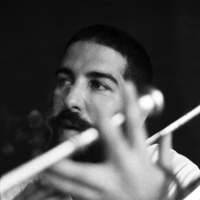 Antonio Neves
Antonio NevesA Pegada Agora é Essa
Far Out Recordings
2021
A Pegada Agora É Essa (The Sway Now) illustrates why multi-instrumentalist, composer and arranger Antonio Neves creates such commotion in modern Brazilian music.
His second release as a leader, The Sway Now weaves a thick tapestry of Brazil's 2021 musical landscape in bold and brash, overlapping and overflowing colors. It threads together generations of Brazilian musicians, from legendary saxophonist Leo Gandelman to younger lions such as singer Alice Caymmi (Danillo's daughter and Dorival's granddaughter) and double-bassist Andre Vasconcellos, and even Neves' own father Eduardo, a renowned saxophonist, conductor and Julliard professor who contributes flute to the closing "Jongo No Feudo."
"My offer to the musicians was complete freedom to express themselves through the songs I proposed—classics like 'Summertime,' 'Luz Negra' and 'Noite de Temporal' and compositions of my own—creating a space of authorship for the band and the guests," Neves explains. "A space for inventions, purges, delusions, laughter. The idea was to bring the freedom of jazz crossed by Brazilian rhythms."
The Sway Now ripples, crackles and explodes like electricity with freedom, jazz and crossing rhythms. Every track includes the leader on drums and trombone, Joana Queiroz on bass clarinet, and a double-bassist (either Vasconcellos or Alberto Continentino), so this music sounds deep. It also changes directions, keys, time signatures and rhythms so tempestuously that it's impossible to tell where the songs end and the freedom begins. But maybe that's the point...
Baritone sax huskily sighs the first verse to "Summertime" then hands it off for Neves' trombone to moan in that same breathless wobble. Neves sings the third verse like a meowing cat, smearing the melody's notes together then pulling them apart, playfully stretching out.
"Summertime" follows "Lamento De Um Perplexo," which opens with the sound of a striking match and then languidly floats into its blues-ballad, happy to be sad melody, tied up by Gandelman's alto sax and Neves' trombone into pretty ribbons and bows.
Neves paints Alice Caymmi's vocal in "Noite de Temporal" into a dark jungle of rhythm by doubling on trombone her mysterious chants and moans. "Luz Negra" spotlights Ana Frango Elétrico's vocal, leading the melody with a sound so warm and bright that it glows and, while piano and bass swing the rhythm section heavy and deep, her voice like a siren pulls Neves' trombone into echoing her song behind her. (Neves arranged the music on Frango Elétrico's Little Electric Chicken Heart, which was nominated for a Latin Grammy and voted 2019's Brazilian Music Revelation by The Art Critics Association of São Paulo.)
"Jongo No Feudo" closes with Neves' fierce recitation engulfed in an eruption of volcanic sound.
 Chris Trinidad
Chris TrinidadChris Trinidad y Cancion Tagalog
Iridium Records
2020
The quiet beauty of Chris Trinidad y Cancion Tagalog illustrates the subtleties between volume, power and intensity.
The musician credits on its inner jacket list instruments with quite curious names, including three types of bata drums (okonkolo, itotele and iya) plus bombo and guagua among the percussion instruments, and with bandurria and octavina among the stringed and strummed ones.
But the strangely quiet, beautiful music these instruments render sounds so much more meaningful than the strange sound of their names.
"On this particular album," Trinidad writes in his notes, "I wanted to musically investigate my identity as a Tagalog-speaking Filipino-Canadian while continuing to explore Afro-Cuban music.
"Could there be a musical bridge between the Philippines and Cuba given their shared Spanish colonial history? This project is my artistic response to those questions."
Trinidad's words claim that Cancion Tagalog brings together two separate things, but his music sounds a singular, seamless vision and voice. This doesn't sound like a cross-cultural experiment. It sounds vibrant and alive, and consistently beautiful.
"Lamig Ng Umaga (Cold Fall Morning)" paints a picture of its title quite bright and clear. Trinidad's bass gently nudges the violin and flute forward through the first few verses, and then everyone steps back except for Trinidad and percussionist Raphael Geronimo. A rare bass solo from the leader softly considers and renders each note in a thoughtful sound, and then ends with a gentlemanly bow as it steps back behind the violin and flute again. (Trinidad reprises this song from his 2008 debut Common Themes I.)
"Taal (The Isle of Enchantment)" adds Raquel Berlind's bewitching lead vocal, which seems to grow more beautifully clear (almost transparent) when she raises its volume to help the guitar and bass pull the rest of the music into a swirling whirlpool of trancelike chanting and groove.
Trinidad solos so rarely that they seem worth special mention. "Kay Lungkot Nitong Hating Gabi (How Lonely Is This Midnight)" spotlights Trinidad's bass and octavina (guitar) with Bo Razon's bandurria (lute). Trinidad's bass leads the music with a strong feeling of tango, kind of how Jack Casady's bolero bass line frames "White Rabbit."
"Ang Tangi Kong Pag Ibig (My Only Love)" frames a similar dance between bass and guitar but accompanied by percussion, which eventually clears the floor for one more Trinidad bass solo, thoughtful and deep. "I take a rare bass solo and do my best imitating the melodic ingenuity of some of my bass guitar heroes Pedro Aznar, Tony Levin and Steve Swallow," Trinidad explains. Trinidad certainly pulls through the strong melodicism of Swallow and Aznar, with Levin's influence more inscrutable; more importantly, his bass tones reflect and complement the other instruments' sound like the brushstrokes of a master painter.
Tracks and Personnel
PhoenixTracks: Meeting; Green Nymph; The Partisan Song; Liberation; Balet; Concerto Epico; Thornica; Yellow Sky; Outro.
Personnel: Vasko Atanasovski: alto sax, soprano sax, flute; Simone Zanchini: accordion; Michel Godard: tuba, serpent; Bodek Janke: drums, tabla; Ariel Vei Atanasovski: cello.
Rah! Rah!
Tracks: Blue Lady; Serenade to a Cuckoo; Volunteered Slavery; Simone; Funk Underneath; Theme for the Eulipions; Alfie; Momentus Brighticus; Blues for Alice; I'll Be Seeing You.
Personnel: Claire Daly: baritone saxophone, flute, vocals; Eli Yamin: piano; Dave Hofstra: bass; Peter Grant: drums.
A Swingin' Sesame Street Celebration
Tracks: Sesame Street Theme; Rubber Duckie; It Feels Good (When You Sing a Song); Sing After Me; One of These Things; Elmo's Song; I Don't Want to Live on the Moon; Put Down the Duckie; Ladybugs' Picnic; People in Your Neighborhood; Pinball Number Count; Believe in Yourself; Sing.
Personnel: Sherman Irby: alto sax, clarinet, flute; Ted Nash: alto sax, soprano sax, clarinet, flute, piccolo; Victor Goines: tenor sax, clarinet, bass clarinet; Janelle Reichman: tenor sax, clarinet; Paul Nedzela: baritone sax, clarinet, bass clarinet; Ryan Kisor: trumpet; Marcus Printup: trumpet; Kenny Rampton: trumpet; Wynton Marsalis: trumpet; Vincent Gardner: trombone, sousaphone; Chris Crenshaw: trombone, bass trombone; Elliot Mason: trombone, bass trumpet; Dan Nimmer: piano; Carlos Henriquez: bass, vocals; Jason Marsalis: drums.
The Ultimate Soul & Jazz Revue
Tracks: Disc One: Them Changes; Manteca; Hammond Street; Move On Up; Feel The Bern; Respect; Disc Two: Con Alma And Sax; Groove Me; Don't You Worry 'Bout A Thing; Close To You; Sing A Simple Song.
Personnel: Benjamin Koppel: alto saxophone; Scott Colley: bass; Bernard Purdie: drums; Dan Nimmer: Hammond electric organ; Jacob Christoffersen: Fender Rhodes electric piano, Wurlitzer keyboard, synthesizer; Søren Heller: guitar; Jacob Andersen: percussion; Randy Brecker: trumpet; Marie Carmen Koppel: vocals.
Mariposas Cantan
Tracks: Mambo Mindoro; Mariposas Cantan; Helen of Jazz; Fiesta De Charangueros; A Little Dab'll Do Ya; Quiero Menudo; Mongorama; Quindimbia; Watermelon Man; Descarga Ramon Banda; Como Fue; East L.A. Meets Napa.
Personnel: Justo Almario: tenor sax. flute; Danilo Lozano: flute; Dayren Santamaria: violin; Joey De León: congas; Joe Rotondi: piano; Ramón Banda: timbales; James Zavaleta: vocals; Alfredo Ortiz: vocals, güiro, bell, bongos; George Ortiz: timbales; Ross Schondek: bass; Francisco Torres: trombone; Yoshigei Rizo: vocals; Darynn Dean: vocals; Alexis De La Rocha: vocals.
A Pegada Agora é Essa
Tracks: Simba (featuring Leda); A Pegada Agora é Essa (featuring Marcos "Esguleba" Alcides); Noite de Temporal (featuring Alice Caymmi); Luz Negra (featuring Ana Frango Elétrico); Forte Apache (featuring Hamilton de Holanda); Lamento De Um Perplexo (featuring Leo Gandelman); Summertime; Jongo No Feudo (featuring Edu Neves).
Personnel: Alberto Continentino: double bass; Alice Caymmi: vocals; Ana Frango Elétrico: vocals; André Vasconcellos: double bass; Antonio Neves: drums, trombone, vocals, guitar; Eduardo Farias: piano; Eduardo Neves: flute; Eduardo Santana: trumpet; Filipe Castro: percussion; Gus Levy: electric guitar; Hamilton de Holanda: mandolin; Joana Queiroz: bass clarinet; Leda: vocals; Leo Gandelman: alto sax; Lucas Videla: percussion; Luiz Otávio: Rhodes; Marcelo Costa: percussion; Marcos Alcides Filho: percussion; Marcos "Esguleba" Alcides: vocals, percussion; Roque Miguel: percussion; Thiago da Serrinha: percussion; José Castro, Rudah Guedes, Eduardo Santana, Antonio de Moraes Neves, Gus Levy and Gabriel Ballesté: backing vocals.
Chris Trinidad y Cancion Tagalog
Tracks: Alin Mang Lahi (Any People); Mutya Ng Pasig (The Maiden of Pasig); Ang Tangi Kong Pag Ibig (My Only Love); Jocelynang Baliuag (Jocelyn from Baliwag); Sampaguita (The Flower of Manila); Sa Ugoy Ng Duyan (In The Rocking of the Cradle); Kay Lungkot Nitong Hating Gabi (How Lonely Is This Midnight); Iyo Kailan Pa Man (Yours Forever); Taal (The Isle of Enchantment); Lamig Ng Umaga (Cold Fall Morning); O Ilaw (My Star); Bayan Ko (My Country).
Personnel: Chris Trinidad: bass guitar, octavina, clave, cabasa, vocals; Bo Razon: tres, bandurria, okonkolo, itotele, iya, bombo; Raphael Geronimo: congas, bongó, timbales, güiro, maracas, bells; Carlos Caro: tumba, quinto, tres dos, guagua, chekere; David Lechuga: guitars; John Calloway: flute; Reggie Padilla: tenor sax; Kimwell Del Rosario: violin; Mary Grace Del Rosario: viola; Raquel Berlind: vocals.
Tags
From the Inside Out
Chris M. Slawecki
Adrabesa Quartet
Vasko Atanasovski
Simone Zanchini
Michel Godard
Bodek Janke
Clare Daly
Rahsaan Roland Kirk
Eli Yamin
Dave Hofstra
Peter Grant
Sly & The Family Stone
Jazz at Lincoln Center Orchestra with Wynton Marsalis
jazz at lincoln center orchestra
wynton marsalis
Benjamin Koppel
Randy Brecker
Bernard Purdie
King Curtis
Jacob Christoffersen
Dan Hemmer
Jacob Andersen
King Floyd
Scott Colley
Jose Rizo's Mongorama
Mongorama
Mongo Santamaria
Jose Rizo
Pancho Sanchez
Hubert Laws
Cal Tjader
Justo Almario
Ramon Banda
Joe Rotondi
Francisco Torres
Danilo Lozano
Joey De Leon
George Ortiz
Dayren SANTAMARIA
Antônio Neves
Leo Gandelman
Alice Caymmi
Andre Vasconcellos
Joana Queiroz
Alberto Continentino
Ana Frango Elétrico
Chris Trinidad y Canción Tagalog
Raphael Geronimo
Raquel Berlind
Bo Razon
Jack Casady
Pedro Aznar
Tony Levin
Steve Swallow
PREVIOUS / NEXT
Support All About Jazz
 All About Jazz has been a pillar of jazz since 1995, championing it as an art form and, more importantly, supporting the musicians who make it. Our enduring commitment has made "AAJ" one of the most culturally important websites of its kind, read by hundreds of thousands of fans, musicians and industry figures every month.
All About Jazz has been a pillar of jazz since 1995, championing it as an art form and, more importantly, supporting the musicians who make it. Our enduring commitment has made "AAJ" one of the most culturally important websites of its kind, read by hundreds of thousands of fans, musicians and industry figures every month.


